

Wedding and Bridal Quilts – Then and Now
May 22, 2024

Hi!
Playing around online this week, I came across a mention of Bridal quilts, and this led me down the ‘rabbit hole’ of a bit more research into this style of quilt. I found it really interesting to discover the different styles of bridal quilts, and those made to celebrate weddings, right from medieval times through to Victorian styles and more modern interpretations.
I think this is a fascinating topic, and I really loved the idea that there were ‘rules’ that seemed to go with how and when these quilts were made.
A tradition as old as quilting, is to make quilts to celebrate special occasions, and quilts made by, or for Brides have a long-standing history. Often as ‘special’ quilts, they have been cared for well, and passed down in families, and so we are lucky enough to have a history of these styles of quilts to enjoy today.
Each period of time has differences in cultural significance and sentimental value behind these cherished heirlooms.
Medieval Era: Love in Every Stitch
In the heart of medieval Europe, bride’s quilts emerged as symbols of love and devotion. These handcrafted treasures were more than just pieces of fabric; they were dowry items, carefully stitched by brides-to-be as tokens of their affection. The quilts of this era were adorned with intricate designs and motifs, each imbued with symbolic meaning. From the delicate rosebuds of romance to the sturdy oak leaves of strength and endurance, every stitch was a testament to the bond between bride and groom.
As the centuries passed, bridal quilts in medieval Europe began to incorporate more elaborate designs and motifs. The “Tristan Quilt,” created between 1360 – 1400, is a striking example of this evolution. Depicting scenes from the legendary romance of Tristan and Isolde, this quilt tells a tale of love, betrayal, and redemption—a narrative mirrored in the lives of many medieval couples.
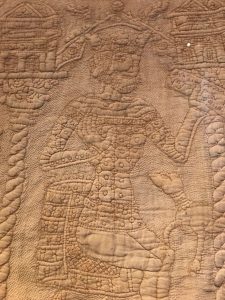
(The “Tristan Quilt” – just look at that stitching!! Image from https://historicaltextiles.org/va-london/)
Renaissance and Baroque Period: Elegance and Opulence
As the Renaissance dawned, bridal quilts evolved into expressions of elegance and opulence. Luxurious fabrics such as silk and velvet became the canvas for elaborate embroidery and intricate designs. Inspired by the art and fashion of the time, these quilts exuded a sense of grandeur and sophistication. From the lavish court scenes of Renaissance Italy to the ornate floral patterns of Baroque France, bridal quilts became masterpieces in their own right, capturing the essence of an era defined by beauty and extravagance.
Victorian Era: Romance and Sentimentality
In the Victorian era, quilts played a central role in the tradition of dowries, symbolizing a bride’s preparedness for marriage and her ability to create a warm and welcoming home. As part of her trousseau—a collection of clothing, linens, and household items assembled by a bride in anticipation of her marriage—a young woman was expected to handcraft a variety of quilts, each serving a specific purpose and embodying different aspects of domestic life.
The idea of quilts as a dowry item was deeply ingrained in Victorian society, reflecting both practical considerations and cultural expectations. Quilts were not only functional bedding but also works of art, painstakingly crafted with love and attention to detail. For a young woman, the ability to create beautiful and functional quilts was seen as a valuable skill, demonstrating her domestic prowess and commitment to her future family.
In preparing her trousseau, a Victorian bride would typically make several types of quilts, each with its own significance and symbolism. One essential quilt in the trousseau was the “Wedding Ring Quilt,” a symbol of eternal love and unity. This quilt featured interlocking rings in various patterns and colors, intricately pieced together to form a continuous circle—a powerful metaphor for the unbreakable bond between husband and wife.
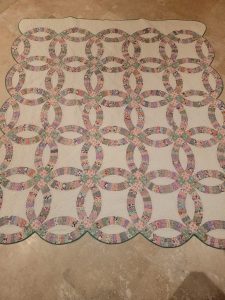
(An early 1900’s Double Wedding Ring Quilt example)
Another popular quilt in the Victorian trousseau was the “Bride’s Bouquet Quilt,” adorned with appliqué flowers and lush foliage. This quilt symbolized the beauty and abundance of married life, with each flower representing a different virtue or aspect of marriage, such as fidelity, love, and prosperity. The bride would painstakingly stitch each flower and leaf by hand, imbuing the quilt with her hopes and dreams for her future.
She may also have made a “Tree of Life” quilt, amongst others in her quilted preparation for marriage. Some sources say, a bride-to-be needed to be prepared with 13 quilts in her trousseau – some proscribed designs, and the 13th was a quilt of her own design, and was to be completely pieced and appliqued by her hands alone. Help was allowed with the quilting of it, but the top was supposed to be all her own work.
It is not realistic to expect that this was the case for every bride of that time, but maybe a goal of sorts to be working toward, in preparation for marriage, and furnishing her own home.
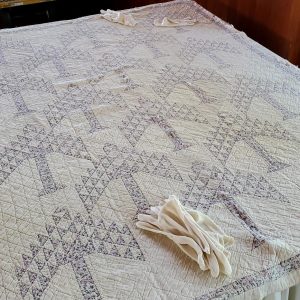
(A vintage “Tree of Life” quilt example. Image from http://www.cherylarkison.com/diningroomempire/2021/9/tree-of-life-vintage-quilt-inspiration )
In addition to these symbolic quilts, a Victorian bride might also include practical quilts in her trousseau, such as “Feather Bed Quilts” or “Counterpane Quilts,” designed to provide warmth and comfort on chilly nights. These quilts were often embellished with elaborate quilting patterns and decorative stitching, showcasing the bride’s skill and creativity as a needleworker.
Overall, the quilts included in a Victorian bride’s trousseau were not only functional household items but also tangible expressions of her love, dedication, and anticipation of married life. Each served a specific purpose and embodied different aspects of domestic life and marital symbolism, as she embarked on her journey into married life.
Modern Revival: Bridal Quilts Today
In today’s world, bridal quilts continue to captivate and inspire couples around the globe. While modern quilters draw inspiration from the past, they also infuse their creations with contemporary flair and personal touches. Minimalist designs, bold colors, and geometric patterns are popular choices for modern bridal quilts, reflecting the diverse tastes and styles of today’s brides and grooms.
As couples embrace the trend of handmade weddings, bridal quilts are experiencing a renaissance of sorts, with more couples opting for personalized, one-of-a-kind creations. From custom-designed quilts featuring the couple’s initials or wedding date to collaborative quilts crafted by family and friends, there’s no limit to the creativity and imagination that can be poured into a modern bridal quilt.
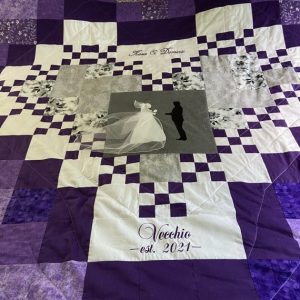
Through the history of bride’s quilts and bridal quilts, we are reminded of the enduring legacy and timeless appeal of these cherished heirlooms. From medieval dowry items to modern-day masterpieces, each quilt tells a story of love, tradition, and craftsmanship—a story that continues to unfold with every stitch.
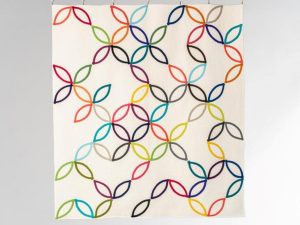
A stunning modern Double Wedding Ring interpretation. (Image from https://craftingalifellc.com/inperson/modern-double-wedding-ring-quilt/ ), or a new take on the traditional, below.
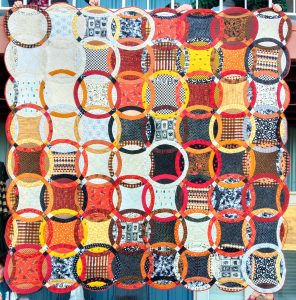
Weddings will always be an occasion that we love to mark with ‘special’ quilts, and it is interesting to see how styles of these bridal quilts have evolved, and will continue to do so, over time.
Enjoy your week!

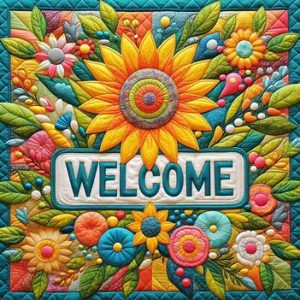

Jodie, I have a quilt that my great grandmother gave to my father for his sixteenth birthday. The name of the quilt is Temperance and Tolerances. I heard that was the quilt in the middle of the 1800’s. I had that quilt framed and hanging on my quilting wall. This reminds me of her hand work and quilt making that I inherited.
Wow! How wonderful for you to have this quilt, and that’s great that you know the history of it too. Definitely a quilt to treasure.